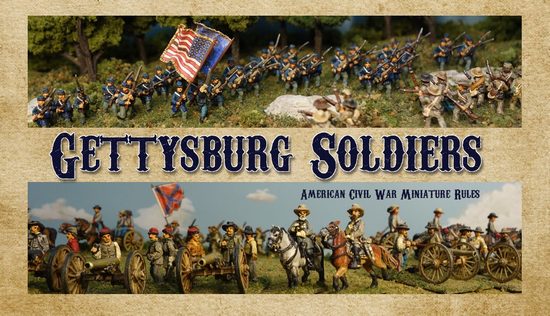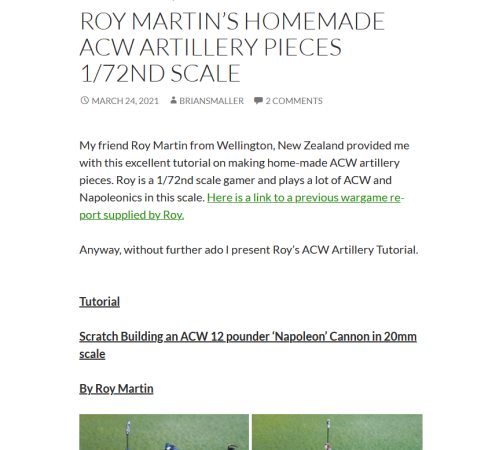
American Civil War Miniature Rules
Total Votes: 8
Description
Players create their armies using the basic units of infantry regiments, cavalry regiments, and artillery batteries. Depending on manpower, an infantry regiment can be represented by between four and twelve stands. One stand in each regiment should have a flag "to lead the regiment." Each cannon model represents a section of artillery, so an artillery battery would typically have two to three artillery models. The artillery crew stand leaves room for a loose artillery model; there are also stands for horses and limbers. Players also need at least one general stand; others may be used as sub-commanders or noteworthy individuals.
The sequence of play is: maneuvering, firing, melee combat. During the maneuvering phase, players dice to see which side moves its units first or second; during the firing phase, players dice to see which side resolves firing first or second.
Infantry and cavalry are in line, column or skirmish formations. Infantry and dismounted cavalry move up to six inches per turn; mounted cavalry move up to twelve inches per turn. Unlimbered artillery can only move one inch per turn; limbered movement varies depending on number of horses (two or four). Rules cover roads, rough terrain, obstacles, buildings, and rivers.
During the firing phase, a player announces all of his targets, measures distances, and rolls 2d6 to resolve firing. Units are discouraged from splitting fire, except for skirmishers which fire individually by stand. Range is twelve inches for infantry and cavalry; 36" for artillery; 'close range' is half that distance. The dieroll is modified by 14 possible conditions, including range, troop experience, presence of a general, terrain, and enfilading fire.
On the Firing Chart, the number of stands firing is correlated against the dieroll to determine the result: number of stands 'killed' (removed, from zero to two), and whether the target must Retreat or Rout. A 'killed' result against artillery will eliminate crew, horses or limber.
Artillery fire is resolved similarly, except that certain modifiers only apply to artillery, and instead of looking up the number of stands firing on the Fire Chart, the player instead looks up the type of target (artillery or non-artillery). When firing on other artillery, the results determine if a hit occurs and what is eliminated (horses, crew, limber, cannon or everything).
Combat results are applied immediately, unless other units are firing at the same target; if so, combat results are applied only after all fire on the same target is resolved.
Melee occurs when a stand moves into contact with an enemy stand, and is resolved at the end of the game turn. Both players roll 2d6, and apply modifiers for terrain, superior numbers, situation, and troop type. The difference is referenced on the Hand-to-Hand Melee Chart to determine the outcome: number of stands lost, and possible Retreat or Rout.
Additional rules cover hidden movement, mortars and siege cannon, and trains, among other things.
Victory is determined by the conditions selected by the players when designing the scenario, such as objectives or casualties.
Editions
First edition published in 2010. Second edition published May 2021.
Supplements
Saratoga Soldiers/Soldados de Alamo

24-page, coil-bound, 5.5" x 10" color booklet. Provides supplemental rules for the American War of Independence (AWI) and the Alamo in two separate sections.
Saratoga Soldiers includes guide to orders of battle, rules changes, new Firing and Hand-to-Hand Melee charts, and glossary.
Soldados de Alamo is specific to the Alamo scenario. Scale is 1 stand = 10 men, 1 cannon model = 1 cannon, with units being infantry companies, cavalry troops, and individual artillery pieces. Provides victory conditions, illustrated order of battle, new Firing and Hand-to-Hand Melee charts, rules changes, and photos of Alamo tabletop layout.









